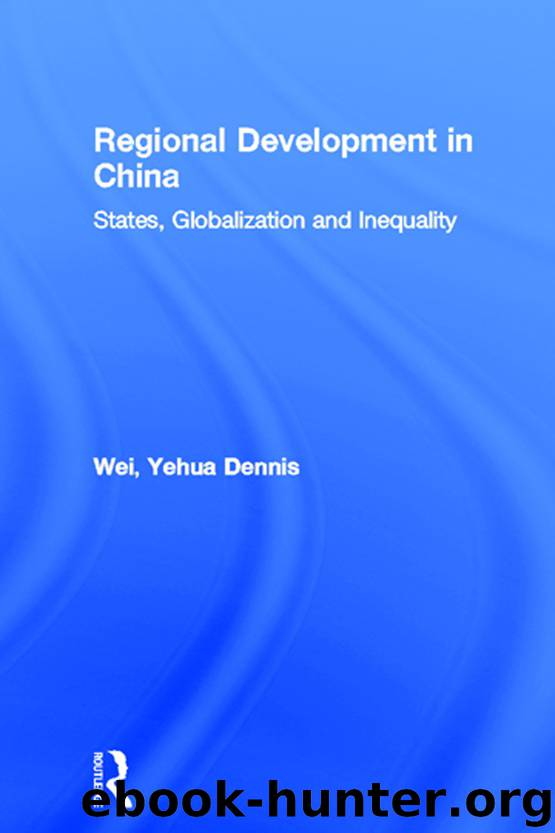Regional Development in China by Wei Yehua Dennis;

Author:Wei, Yehua Dennis;
Language: eng
Format: epub
Publisher: Taylor & Francis Group
Figure 4.4 Provincial distribution of FDI, 1995.
Source: SSB 1996.
Table 4.14 Foreign-invested enterprises in selected provinces, 1995 (US$ million)
Source: SSB 1996.
Table 4.15 Foreign direct investment in SEZs and OCCs (US$ million)
Source: SSB 1992; MFTEC 1994.
Increasing foreign trade is another feature of the post-Mao economy, which is closely related to the development of FDI and FIEs. In 1996, imports and exports of FIEs accounted for 47.3 percent of foreign trade. In terms of regional patterns, the coastal region dominates foreign trade. In 1993, 81.1 percent of China's exports came from the coastal region while those in the central and western regions were only 13.1 percent and 5.8 percent, respectively. Provincial patterns of foreign trade are also spatially uneven (Table 4.16). Guangdong's exports constitute 33.5 percent of China's total, followed by Shanghai (7.1 percent), while in many western provinces, foreign trade was very small.
Several factors have contributed to the leading role of coastal provinces in attracting FDI. First, as I showed in the last section, the central government granted these provinces preferential policies in dealing with foreign investment, currency exchange, and foreign trade. Secondly, these provinces have advantages in location, resources, networks, and local policies. These provinces have locational advantages in foreign investment as well, such as more favorable local policies, more productive economies, a well-developed infrastructure, and a well-trained labor force. They have long-established closer linkages with foreign countries, especially neighboring Asian countries.
Globalization and government policies are important to the growth and distribution of foreign investment. The growth of FDI in China is related to the globalization of economic activities during which FDI has increased at the global scale, including in developing countries. Moreover, the efforts of the central government have also stimulated the growth of FDI in China. Policies towards coastal provinces, especially SEZs and OCCs, have been the most attractive to foreign investors, which have greatly influenced the uneven distribution of FDI in China.
Download
This site does not store any files on its server. We only index and link to content provided by other sites. Please contact the content providers to delete copyright contents if any and email us, we'll remove relevant links or contents immediately.
International Integration of the Brazilian Economy by Elias C. Grivoyannis(75663)
The Radium Girls by Kate Moore(11636)
Turbulence by E. J. Noyes(7717)
Nudge - Improving Decisions about Health, Wealth, and Happiness by Thaler Sunstein(7261)
The Black Swan by Nassim Nicholas Taleb(6783)
Rich Dad Poor Dad by Robert T. Kiyosaki(6192)
Pioneering Portfolio Management by David F. Swensen(6089)
Man-made Catastrophes and Risk Information Concealment by Dmitry Chernov & Didier Sornette(5672)
Zero to One by Peter Thiel(5505)
Secrecy World by Jake Bernstein(4404)
Millionaire: The Philanderer, Gambler, and Duelist Who Invented Modern Finance by Janet Gleeson(4114)
The Age of Surveillance Capitalism by Shoshana Zuboff(4000)
Skin in the Game by Nassim Nicholas Taleb(3978)
The Money Culture by Michael Lewis(3857)
Bullshit Jobs by David Graeber(3847)
Skin in the Game: Hidden Asymmetries in Daily Life by Nassim Nicholas Taleb(3736)
The Dhandho Investor by Mohnish Pabrai(3573)
The Wisdom of Finance by Mihir Desai(3538)
Blockchain Basics by Daniel Drescher(3341)
